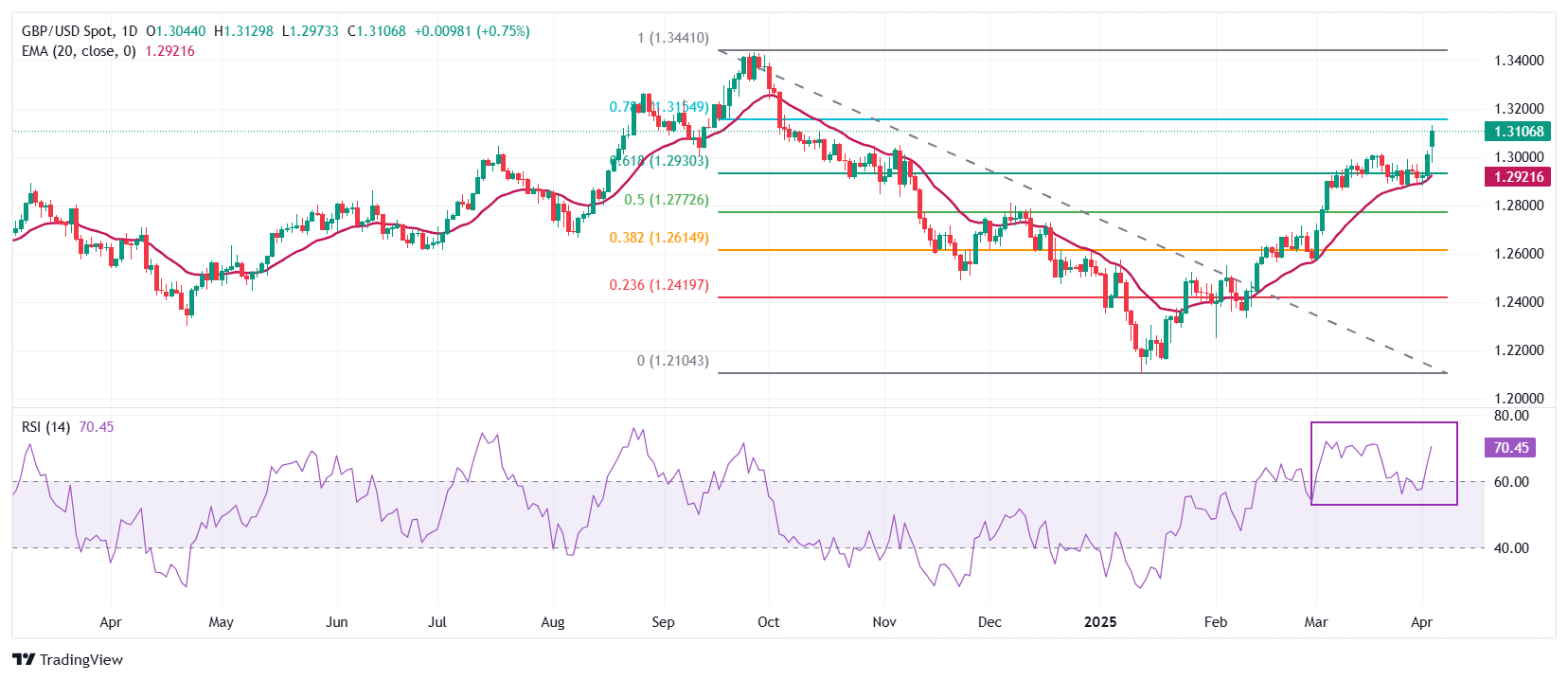GBP rallies against US Dollar as Trump tariffs stoke recession fears
- The Pound Sterling jumps above 1.3100 against the US Dollar as higher-than-anticipated Trump’s tariffss have prompted risks of a US recession.
- President Trump imposed 10% tariffs on the UK, the lowest level across all trading partners.
- The UK is unlikely to retaliate against US tariffs.
The Pound Sterling (GBP) surges above 1.3100 against the US Dollar (USD) during the European trading hours on Thursday, the highest level seen in almost six months. The GBP/USD pair soars as the US Dollar plummets after United States (US) President Donald Trump unveils worse-than-expected tariffs for his trading partners.
The US Dollar Index (DXY), which tracks the Greenback’s value against six major currencies, tumbles to near 102.70.
US President Trump announced a 10% baseline duty on all products entering the US and additional specific levies on the majority of its trading allies, which have followed threats of countermeasures by their leaders. Market participants expect that the full-scale implementation of tariffs will lead the US economy to a recession. Such a scenario underpins the need for more interest rate cuts from the Federal Reserve (Fed) despite knowing that higher levies have also stoked worries about persistent inflation.
US Council of Economic Advisers Chair Stephen Miran also agreed to expectations that Trump’s protectionist policies could lead to “short-term bumps” in the economy, as per his interview with Fox Business. However, he clarified that the president is focused on “long-term economic transition” and improvement in the “durability, sustainability and fairness” of the American economy with respect to the rest of the world.
Going forward, investors will pay attention to the US S&P Global and the ISM Services Purchasing Managers’ Index (PMI) data for March, which will be published during North American trading hours. The US S&P Global Services PMI is estimated to remain in line with preliminary expectations of 54.3. The US ISM Services PMI is expected to come in lower at 53.0 from February’s reading of 53.5, suggesting that activities in the services sector grew moderately.
Daily digest market movers: Pound Sterling is expected to outperform
- The Pound Sterling exhibits a different performance with each of its major peers on Thursday. The outlook of the British currency appears to be healthier as US President Trump has imposed the lowest tariffs on the United Kingdom (UK). Trump slapped a 10% levy on Britain, which was the minimal figure seen in the reciprocal tariff chart.
- The lower tariffs by Trump on the UK don’t indicate that the impact on the economic outlook will be limited. UK firms would face tough competition in the global market from businesses of those nations that have attracted fat import duties from the US. Higher tariffs on those companies will make their products less competitive in the US, forcing them to offer lower prices globally.
- Contrary to other leaders who are preparing for countermeasures against Trump’s tariffs, the UK is unlikely to retaliate. Before tariffs were revealed, UK Prime Minister Keir Starmer said, “I really do think it is not sensible to say the first response should be to jump into trade war with the US as government braces itself for the announcement of widespread taxes on imports,” according to BBC News. However, he didn’t rule out that the administration has been actively preparing for all “eventualities” ahead of President Trump’s announcement of “planned tariffs”.
- In Thursday’s session, investors await the release of revised UK S&P Global/CIPS Composite and Services PMI data for March, which will be published at 08:30 GMT. The Composite and Services PMI are expected to have remained in line with preliminary expectations of 52.0 and 53.2, respectively.
Technical Analysis: Pound Sterling climbs above 1.3110

The Pound Sterling rallies to near 1.3110 against the US Dollar after building base around the 61.8% Fibonacci retracement, plotted from late-September high to mid-January low, near 1.2930. The upward-sloping 20-day Exponential Moving Average (EMA) near 1.2922 suggests the near-term outlook is bullish.
The 14-day Relative Strength Index (RSI) jumps around 70.00 after cooling down to near 60.00, indicating that the bullish momentum has resumed.
Looking down, the 61.8% Fibonacci retracement at 1.2930 will act as a key support zone for the pair. On the upside, the September 26 high of 1.3434 will act as a key resistance zone.




